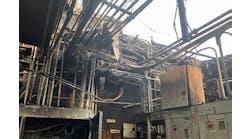Auto industry empowering workers to foster flexibility
At Navistar International, machine learning and artificial intelligence (AI) are pieces in a complex puzzle that Mark Hernandez is putting together. “How do we use AI and machine learning? How do we get to that level? You need to take the first step,” he explained during the Automotive & Tire Industry Forum at this week’s Automation Fair At Home.
Just like every other industry, the automotive sector has benefited from available technology, especially during the global pandemic. In an industry requiring more and more mixed manufacturing, it’s important to implement technology that creates flexibility and empowers operators.
“We’re going to continue to get more technical,” explained Brian Jacobs, director, manufacturing engineering, Adient, which builds equipment for the sector. “We’re going to start to see more technologies in the plant that we’re used to in our personal lives. I’m getting notifications on my phone that my bank account is low, and my wife has been out shopping. Information is out there. The shop floor is like that. The key to empowering people is getting the right information to the right people at the right time. That means getting information to our shop-floor leaders.”
Jacobs was part of a panel discussion in the Automotive & Tire Industry Forum during Automation Fair At Home, presented by Rockwell Automation. “We’ve seen a lot of fluctuations in our workforce,” said Jacobs. “So we rely on standardization in our systems to provide consistency from person to person. Doing remote equipment runoffs (commissioning and start-up) has turned out to be very successful because we’re able to have people involved that normally wouldn’t travel.”
Remote runoffs are a technology you wouldn’t have seen in the automotive industry a year ago, said Jason Cleveland, vice president, engineering, Eagle Technologies. “But we’ve been forced down that path,” he explained.
Eagle Technologies’ customers run the gamut in terms of their journeys into digital transformation. “Some are trying to accelerate their journeys,” explained Cleveland. “Some are still trying to figure it out. And there’s a group letting other companies figure it out. COVID has forced a lot of companies off dead center and made them accelerate.”
“As a startup, we have a lot of challenges,” proclaimed Michael Boike, director of manufacturing for electric-vehicle-maker Lucid Motors. “We have to design a vehicle, scale the supply chain, scale the organization. One thing I spend a lot of time on with my team is culture and empowering the workforce. I’m not just launching a car or a plant; I’m launching a company. I need leaders. I need people who are qualified and willing to take on the challenge of doing something different. Our number one goal is to remove barriers for our employees.”
Technology tools help to build confidence and train an employee better. “We want to make sure every employee is a team member,” emphasized Boike. “They all get stock options. That creates one big team with one goal moving forward.”
Lucid has recruited individuals from all over the automotive industry. From the interview process and onboarding through training, it’s all about empowering employees, not just with confidence, but also with the right information. How do you make the work instructions more visible? “MES (manufacturing executions systems) helps with a portion of it,” said Boike. “Artificial intelligence (AI) is great, too. I want not only a robot to be able to predict when it’s going to fail, but I want it to order its own parts.”
At Navistar International, machine learning and artificial intelligence are pieces in a complex puzzle that Mark Hernandez, senior vice president, global manufacturing and supply chain, is putting together. “How do we use AI and machine learning? How do we get to that level? You need to take the first step,” he explained.
“With Navistar, we’re building a 1-million-square-foot plant in San Antonio, Texas,” said Hernandez. “We’re going to build electric vehicles and diesel on the same assembly line.” Without a dedicated vehicle type, the facility will have the flexibility of being able to react to the market. If diesel or electric takes off or slows, the plant will be able to adapt. Hernandez is counting on a 5-30% efficiency improvement in the new plant.
“When I look at technology and the future of automotive, there’s a lot of stress on people. The first step is to make assemblers’ jobs easier on the assembly line. Also, how do we create faster feedback loops to make better decisions? The third piece is the high level. We have mixed-model manufacturing. We may build a 100-hour vehicle right after a 70-hour vehicle. A lot of people say, ‘Manufacturing 4.0,’ and think predictive maintenance. The real unleashing of this is the supply chain. Our supply chains flex every day. How do I predict that and leverage the supply chain?”
The keys are getting information to the operators and helping them do their jobs, explained Cleveland. “One way is with augmented reality (AR), overlaying information onto your real work environment,” he said. “In our implementation, AR walks the person through procedures on an iPad. You have an opportunity to guide them. That’s one of the up-and-coming technologies on all fronts.”
Digital transformation occurs at different speeds from company to company. But these times have made it necessary for organizations to accelerate their digital journeys. Still, there are going to be some obstacles.
“The value is becoming clearer,” said Jacobs. “In the applications we’ve dealt with, we’ve had to rely on technology. We had equipment built in Europe, and we needed support here in the United States. We were able to use HoloLens from Microsoft to bring people remotely on-site. It was a big help.”
Technology has seen more investment in part because top-level executives are seeing the economic benefits of automation. “If you looked 15-20 years ago, investment in IT infrastructure was difficult to secure,” said Hernandez. “Today there’s a lot more knowledge base among senior executives, because technology investment is tied to financial results.”
Changing the production system and management system will only get you so far. You have to change the culture, too. “If you don't do all three well, you’ll fail,” said Hernandez. “Seventy percent of failures are because of culture and mindset.”
Companies are also using simulation to predict how new processes will perform. “The amount of the complexity in our materials has grown very high in the past 10 years,” explained Jacobs. “Having technology that helps us understand and manage that complexity is a clear value. We can’t do everything at once, so where is the best value and the right place to start?”
Simulation has already come a long way to help to predict performance during the design phase, and it reduces the testing modes, said Boike. “We’re going to build a factory in less than a year,” he explained. “Simulation saves time by avoiding rework.”
[sidebar id=2]






